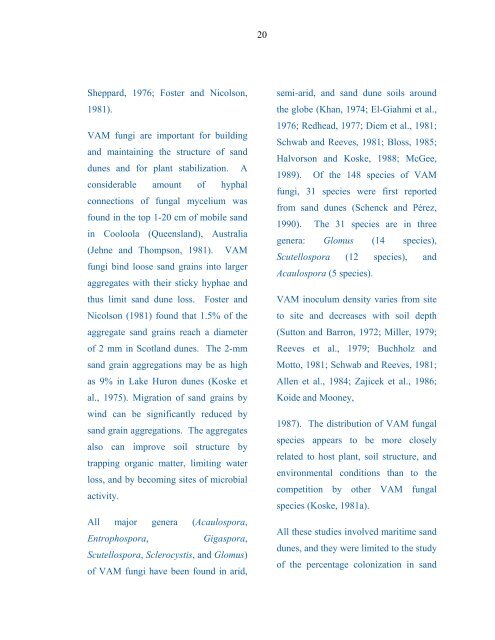Taxonomy and Ecology Of Inland Sand Dune ... - Mycorrhizae
Taxonomy and Ecology Of Inland Sand Dune ... - Mycorrhizae
Taxonomy and Ecology Of Inland Sand Dune ... - Mycorrhizae
You also want an ePaper? Increase the reach of your titles
YUMPU automatically turns print PDFs into web optimized ePapers that Google loves.
20Sheppard, 1976; Foster <strong>and</strong> Nicolson,1981).VAM fungi are important for building<strong>and</strong> maintaining the structure of s<strong>and</strong>dunes <strong>and</strong> for plant stabilization. Aconsiderable amount of hyphalconnections of fungal mycelium wasfound in the top 1-20 cm of mobile s<strong>and</strong>in Cooloola (Queensl<strong>and</strong>), Australia(Jehne <strong>and</strong> Thompson, 1981). VAMfungi bind loose s<strong>and</strong> grains into largeraggregates with their sticky hyphae <strong>and</strong>thus limit s<strong>and</strong> dune loss. Foster <strong>and</strong>Nicolson (1981) found that 1.5% of theaggregate s<strong>and</strong> grains reach a diameterof 2 mm in Scotl<strong>and</strong> dunes. The 2-mms<strong>and</strong> grain aggregations may be as highas 9% in Lake Huron dunes (Koske etal., 1975). Migration of s<strong>and</strong> grains bywind can be significantly reduced bys<strong>and</strong> grain aggregations. The aggregatesalso can improve soil structure bytrapping organic matter, limiting waterloss, <strong>and</strong> by becoming sites of microbialactivity.All major genera (Acaulospora,Entrophospora,Gigaspora,Scutellospora, Sclerocystis, <strong>and</strong> Glomus)of VAM fungi have been found in arid,semi-arid, <strong>and</strong> s<strong>and</strong> dune soils aroundthe globe (Khan, 1974; El-Giahmi et al.,1976; Redhead, 1977; Diem et al., 1981;Schwab <strong>and</strong> Reeves, 1981; Bloss, 1985;Halvorson <strong>and</strong> Koske, 1988; McGee,1989). <strong>Of</strong> the 148 species of VAMfungi, 31 species were first reportedfrom s<strong>and</strong> dunes (Schenck <strong>and</strong> Pérez,1990). The 31 species are in threegenera: Glomus (14 species),Scutellospora (12 species), <strong>and</strong>Acaulospora (5 species).VAM inoculum density varies from siteto site <strong>and</strong> decreases with soil depth(Sutton <strong>and</strong> Barron, 1972; Miller, 1979;Reeves et al., 1979; Buchholz <strong>and</strong>Motto, 1981; Schwab <strong>and</strong> Reeves, 1981;Allen et al., 1984; Zajicek et al., 1986;Koide <strong>and</strong> Mooney,1987). The distribution of VAM fungalspecies appears to be more closelyrelated to host plant, soil structure, <strong>and</strong>environmental conditions than to thecompetition by other VAM fungalspecies (Koske, 1981a).All these studies involved maritime s<strong>and</strong>dunes, <strong>and</strong> they were limited to the studyof the percentage colonization in s<strong>and</strong>


